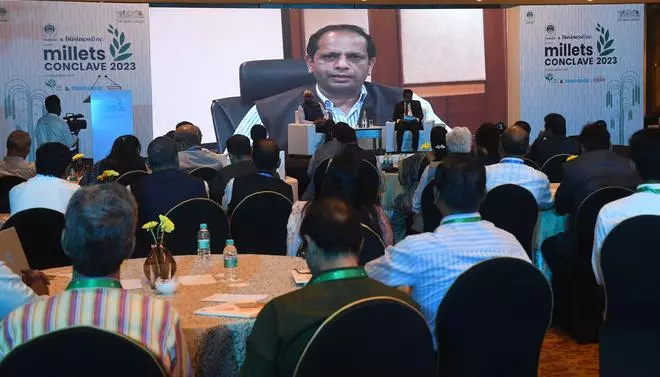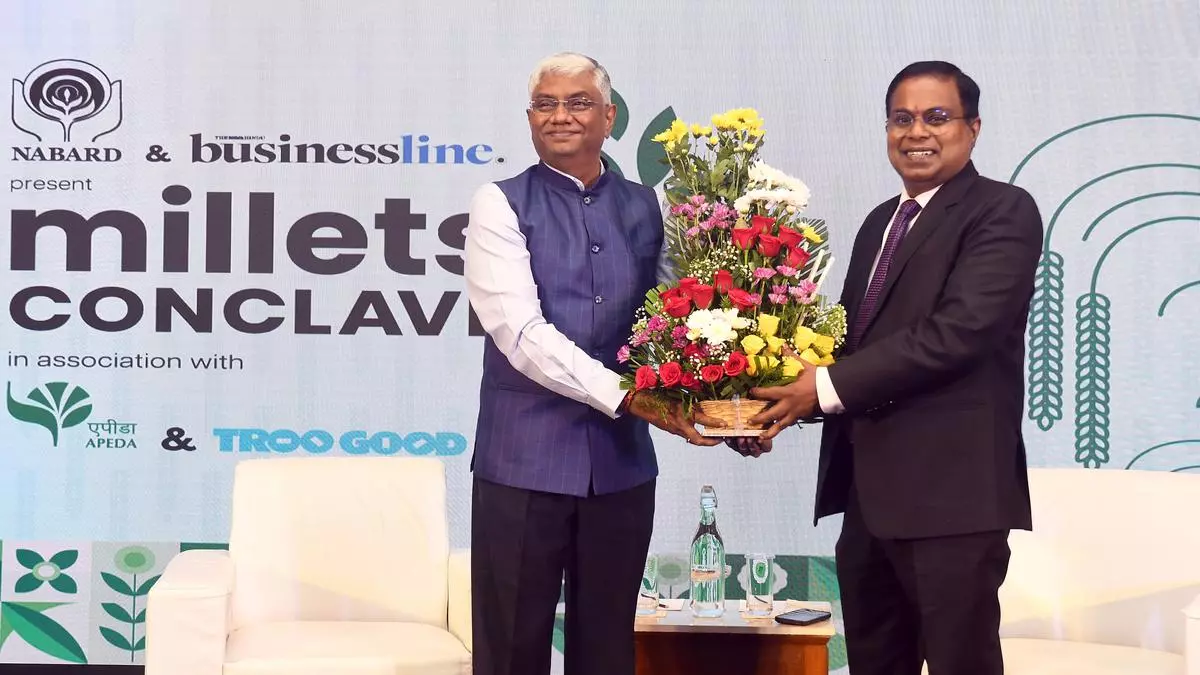Millets production set to triple by 2030: Nabard Chairman
Setting the tone for the future of millets in the International Year of millets, Shaji KV, Chairman, National Bank for Agriculture and Rural Development (Nabard) said the target is to triple their production to 45 million tonnes by 2030 and it is possible to do it.
“We are trying to bring back the area under millets which has dwindled,” he said.
Shaji KV, Nabard Chairman, addressing the Millets Conclave 2023 in Hyderabad on Friday, September 15, 2023
| Photo Credit: NAGARA GOPAL
Addressing Nabard-businessline Millets Conclave 2023, here on Friday, he said India accounts for 41 per cent of the global millets production. It accounts for 81 per cent of the arable land under millets in Asia.
The millets production target for the current year is at 17 million tonnes and is set to reach 45 million tonnes by 2030.
“Millets have a crucial role to play in the nutritional security of the country… With food security not a major concern now, we are looking at sustainability. Millets are efficient in fixing carbon and don’t need that much water and are also heat resistant ..the duration of the millets crop is less by 60 per cent compared to other cereals so the risk to the farmer is less and it’s time to renew millets cultivation,” he said.
According to him, improving per unit productivity of millets will help address rural distress and nutritional security. Besides, 50 per cent of the population is dependent on agriculture, which supports 17 per cent of GDP.
Talking about the role Nabard can play, he said, “We are trying to take people out of pure agriculture activities to agri-processing. We are trying to rediscover co-operatives. Co-ops were the original FPOs.”
Shaji said there is a need to improve the yield gap between various geographies of millets cultivation. “If yield gaps are bridged, productivity can be increased,” he said.
It also can be distributed through PDS, he said.
Nabard along with APEDA is opening a line of exports, Shaji said, adding that “₹600 crore Nabard Fund is being utilised for promoting start-ups in millets. The funding is done through our subsidiary, Nabventures.”
Nabard is trying to create derivative products for FPOs through NCDEX and is working with RBI to redefine the Kissan credit card, looking at credit card innovations and making it not only for use in agriculture but also for farmers’ allied activities, he said.

Himanshu Pathak, Director-General of the Indian Council of Agricultural Research (ICAR) addresses Millets Conclave-2023
| Photo Credit: NAGARA GOPAL
In a virtual address, Himanshu Pathak, Director-General of the Indian Council of Agricultural Research (ICAR), said, “Millets have been a traditional food of India but had lost its sheen with more production of rice and wheat after the Green Revolution.”
Global production of millets is about 100 million tonnes from about 80 million hectares of land. Sorghum and pearl millets, the most important millets, comprise more than 90 per cent of area under production.
Keeping with the clean environment narrative, millets can fix carbon, nitrogen better. They adapt very well to lower soil fertility, he explained.
To promote millets, there are certain things to be done in the area of science, economics and also policy fronts, he added. In the area of science there is a need to develop high-yielding varieties with good practices to increase productivity and production. Over the last five years, ICAR has developed 133 varieties.
“Efforts of all stakeholders is required to create a win-win situation and let us sensitise the civil society in the International Year of Millets,” he said, adding, “let us make way for millets to the main stream of crop cultivation.”
In his welcome address, businessline Editor Raghuvir Srinivasan said millets will have a crucial role to play in the country’s nutritional security.
In his special address, delivered virtually, APEDA Chairman Abhishek Dev said India targets to export $100 million worth of millets by 2025. In the 2022-23 fiscal, millets exports were $75.43 million.
The United Arab Emirates and Saudi Arabia make up 55 per cent of the export basket, while Nepal, Japan, Germany, Bangladesh and Egypt contribute 10 per cent.
Millets are crucial since 42 per cent of the people survive on starchy staples and 600 million are chronically undernourished, he said.
India contributes 20 per cent of global and 80 per cent of Asia’s millet production, Dev said. APEDA had conducted a number of events abroad and during the latest G-20 event to popularise millets.
APEDA and TrooGood are the associate partners of the event and NewsX is the TV Partner.
